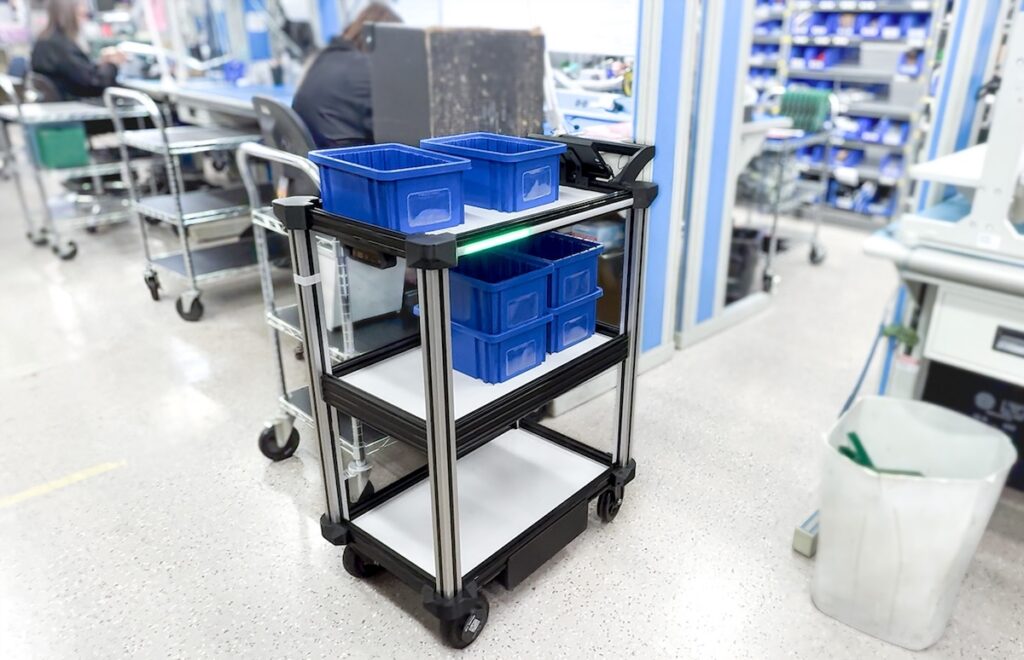The Comparison:
At first glance, a robotic vacuum gliding across a living room and an Autonomous Mobile Robot (AMR) cart rolling through a warehouse may look like distant cousins. Both move autonomously, avoid obstacles, and recharge on their own. Yet one costs a few hundred dollars, while the other can reach tens of thousands. Why the massive gap?
Component Quality: Consumer Grade vs. Industrial Grade
The most immediate difference comes down to component quality. Home robotic vacuums use consumer-grade parts, motors, sensors, plastics, and drive systems built for light duty. They’re designed to meet cost expectations and typically last two to three years of casual use.
AMR carts, by contrast, use industrial-grade components engineered for endurance. They carry heavy payloads, run 8 to 16 hours a day, and operate through dust, vibration, temperature swings, and uneven floors. Every element, from bearings and wheels to motor drivers and connectors, is chosen for reliability, safety, and long-term durability.
Load Capacity: A lot vs A little
A robotic vacuum carries only itself, plus a small bin of dust weighing less than a kilogram. It doesn’t push, pull, or transport meaningful loads. An AMR cart, by contrast, is expected to carry 75 kg or more, sometimes even hundreds of kilograms. This demands far stronger frames, torque-dense motors, higher-capacity batteries, and advanced motion control algorithms.
Battery Size and Runtime
Your home vacuum runs for about 1–2 hours before returning to its dock. That’s plenty for a few rooms.
An AMR cart is designed for 12–16 hours of continuous operation, often across multiple shifts. Its lithium battery pack can be as large as a small car’s, allowing for better usage.

Navigation Scale: A Few Rooms vs. Thousands of Square Feet
A home vacuum navigates predictable, confined spaces, flat floors, a few rooms, and little variation. It relies on simple sensors like infrared, bumpers, and basic cameras to get the job done.
AMR carts, on the other hand, move through complex, ever-changing environments such as warehouses, hospitals, and factories that span tens of thousands of square feet. They continuously localize their position within centimeters, adapting to shifting layouts and lighting conditions.
Software Complexity
The software stack behind a home vacuum is relatively straightforward: basic path planning, room mapping, docking logic, and app control. In contrast, an AMR runs a full autonomy stack similar to self-driving cars: SLAM, sensor fusion, dynamic avoidance, fleet management, and cloud integration.
Durability and Environment: Living Room vs. Factory Floor
Consumer robots work on hardwood, tile, or carpet—stable, climate-controlled environments. They don’t encounter oil spills, metal shavings, or ramps. AMRs must traverse industrial floors with debris, thresholds, inclines, and varying traction. Their wheels are larger, their suspensions more robust, and their enclosures sealed against dust and moisture.
Speed and Obstacle Avoidance
A home robot vacuum creeps along at about 0.2–0.3 meters per second. If it bumps into a chair, no harm done. An AMR cart moves three to five times faster—up to 0.9 meters per second or more—and often shares space with people, forklifts, and other robots. Its obstacle avoidance must be predictive, not reactive.
Software Complexity
The software stack behind a home vacuum is relatively straightforward: basic path planning, room mapping, docking logic, and app control. In contrast, an AMR runs a full autonomy stack similar to self-driving cars: SLAM, sensor fusion, dynamic avoidance, fleet management, and cloud integration.
Safety, Compliance, and Certification
A consumer vacuum might meet FCC and basic electrical safety standards. An AMR must comply with ISO 3691-4, UL certifications, EMC/EMI testing, and functional safety systems for braking and speed limiting.
Maintenance and Lifecycle
A home vacuum is disposable after a few years. When it breaks, you replace it. An AMR is expected to run for years or even decades, with serviceable parts, modular subsystems, and remote diagnostics.
The Economics of Scale
Millions of consumer vacuums are produced every year, driving component costs down through massive economies of scale. AMRs, however, are still produced in small volumes—hundreds or thousands annually. Each carries the burden of R&D, certification, and integration costs.
Conclusion: Built for Different Worlds
A robotic vacuum cleaner and an AMR cart may share a common ancestor in robotics, but their worlds couldn’t be more different. One is designed for comfort, convenience, and cost; the other for strength, endurance, and reliability.
It’s just that simple: home vacuums cost a few hundred dollars, and AMR carts cost thousands. However, one is built to clean your living room; the other is built to move the world.